Menus
- Running miracle reissued
- Compared to the previous model, the bench is divided into two parts
- New control electronics and ride-by-wire on board
- VTEC must be checked every 25,000 kilometers
- Superb workmanship, rich sound and a safe driving experience
- The increase in strength of the previous model is more noticeable
- System designed for security
- Technical specifications
- MOTORCYCLE measurements
- Mileage
- Driving dynamics
- Comparison of the RC46 VTEC with the RC79
- competitor
- MOTORCYCLE scoring
- Conclusion Honda VFR 800 F
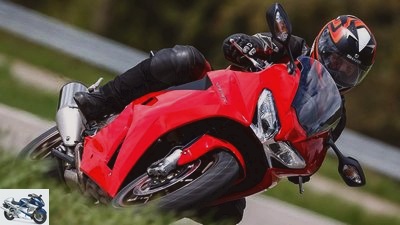
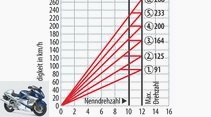
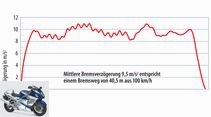
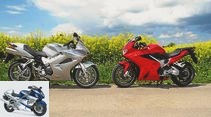
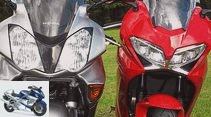
25th photos
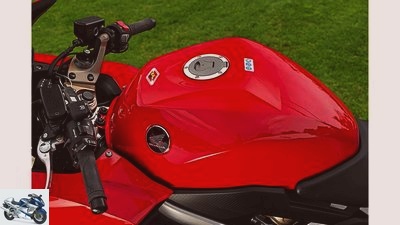
Montero
1/25
The cap pulls out gasoline by suction (negative pressure) and is opened when the tank is almost full or half full.
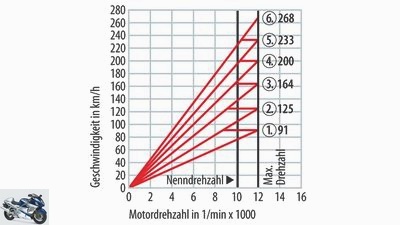
Henniges
2/25
Transmission measurements of the Honda VFR 800 F.
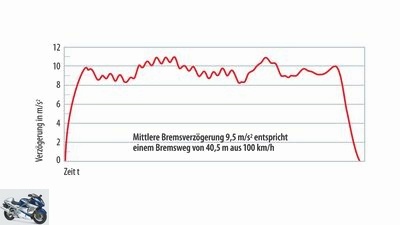
Henniges
3/25
Although the fork plunges very deeply when braking hard, the Honda VFR 800 F still remains stable on course and the rear wheel always maintains contact with the ground.
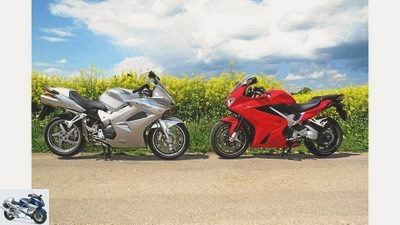
Henniges
4/25
The new one looks more delicate and is slightly lighter than the previous one. Is this really noticeable when driving?
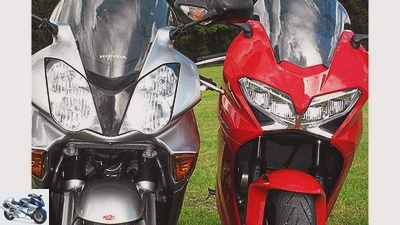
Henniges
5/25
The high-lying exhaust and the two twin headlights arranged one above the other were striking. The new Honda VFR 800 F is much more mainstream.
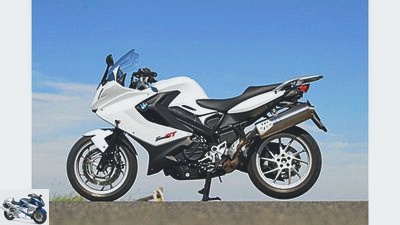
Rivas
6/25
Competition: BMW F 800 GT.
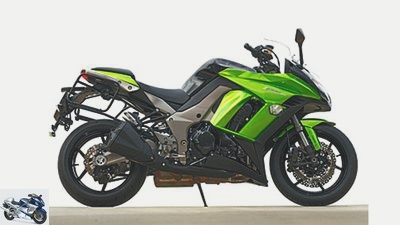
Bilski
7/25
Competition: Kawasaki Z 1000 SX.
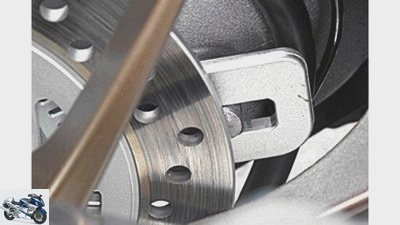
Henniges
8/25
More elegant than on the RC46: The brake calliper’s counter holder is simple and now integrated.
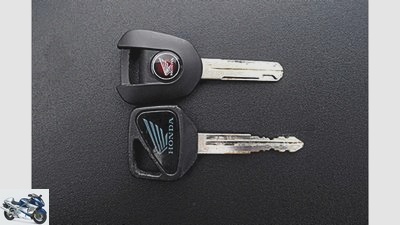
Henniges
9/25
Beard trimmed: The ignition key awl is a thing of the past – the new key is easier to insert.
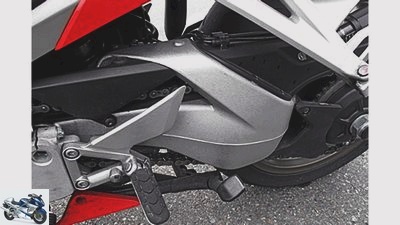
Henniges
10/25
More stable: Honda has given the single-sided swing arm an upper pull that makes it more torsion-resistant.
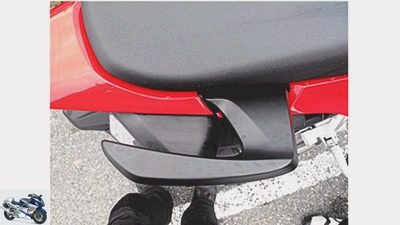
Henniges
11/25
Cumbersome: If you want to mount the passenger cover, you have to unscrew the handles and bench beforehand.
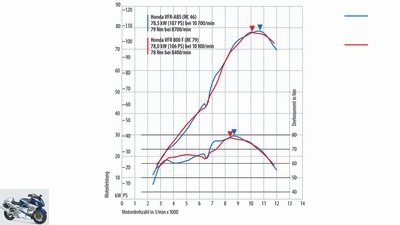
Henniges
12/25
Engine measurements of the Honda VFR 800 F.
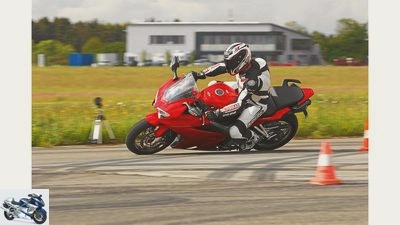
13/25
Hard at the limit: The Honda VFR 800 F has to show what it can do on the top test course.
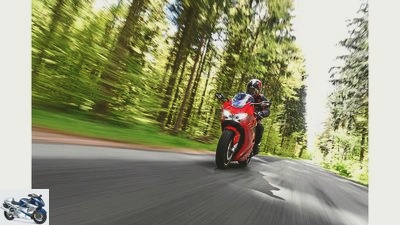
14/25
Precise, true to the line, suitable for everyday use, robust, high-quality: the strengths of the Honda VFR 800 F have been further developed – a companion for life.
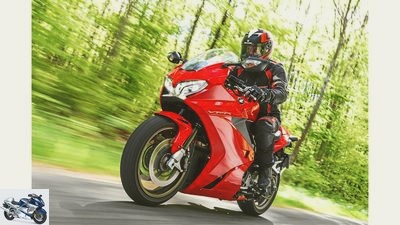
15/25
The top test explains why switching to the new one is worthwhile even for fans and why those who are inexperienced VFR should definitely test drive.
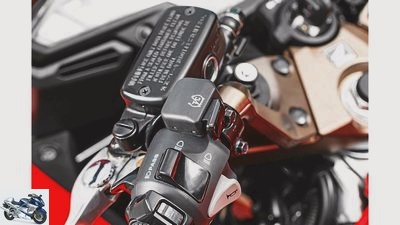
16/25
With buttons: a delicate switch for the heated grips, a large one for traction control.
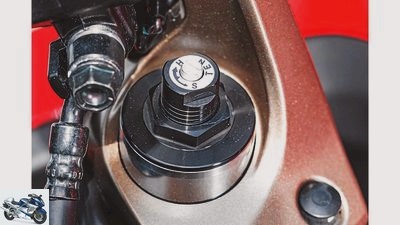
17/25
Both the spring base and the rebound damping can be varied on the fork.
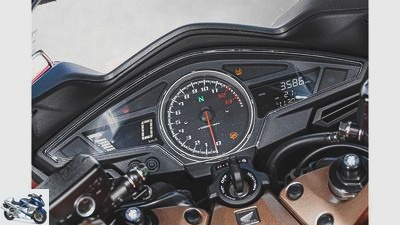
18/25
Clear, informative and resiliently attached – the new cockpit looks valuable and pleasing.
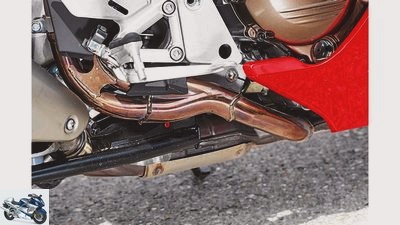
19/25
Elaborate manifold routing for the two rear cylinders – all made of stainless steel, of course.
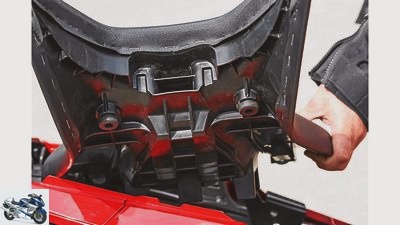
20/25
The seat is in two parts, with the driver’s seat screwed on and height adjustable.
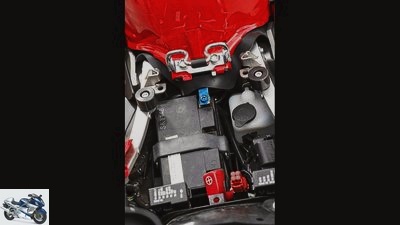
21/25
View under the bench: tidy, everything easily accessible and processed in every corner.
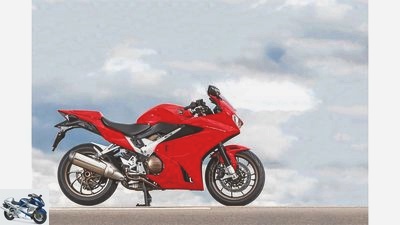
22/25
The Honda VFR 800 F.
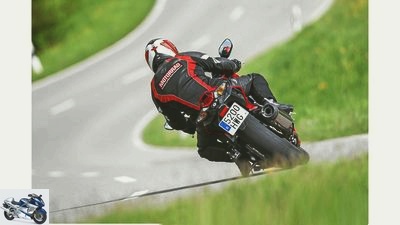
23/25
A beautiful back can also delight: The rear of the VFR is a success, the indicators are well integrated.
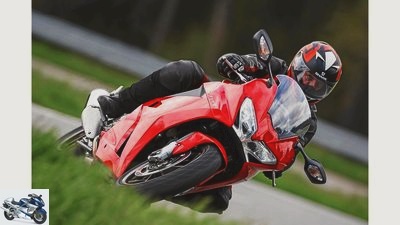
24/25
Slope-friendly: The VFR was and is a real sports tourer with virtues from both worlds.
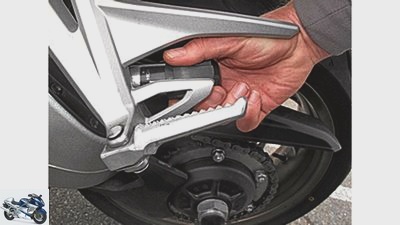
Henniges
25/25
Not exactly ideal: The handwheel for adjusting the spring base is difficult to access.
Honda VFR 800 F in the top test
Running miracle reissued
VFR owners have never made a big fuss about their motorcycle. Why also? All model variants are almost indestructible, superbly processed and ideal companions for small and large tours. The top test explains whether switching to the new Honda VFR 800 F is worthwhile.
You seldom stand on stage to blow the horn hard. No, the VFR community prefers to ride a motorcycle instead of philosophizing about it. And she drives a lot and loves to drive. Mileage of 200,000 kilometers per model is not uncommon. That brings together quite a bit. Around 75,000 VFR models of all construction years are currently still romping around on Europe’s roads. By introducing the new Honda VFR 800 F this number is likely to increase further.
Buy complete article
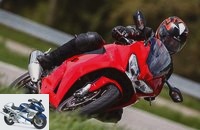
Honda VFR 800 F in the top test
Running miracle reissued
RC79 is the sixth generation
Dealers are faced with the difficult task of making long-established VFR drivers the advantages of the Honda VFR 800 F over old models palatable. Or explain the added value to new customers compared to competing models. Because with a price of 11,990 euros it is 350 euros cheaper than its predecessor, but still far from a bargain.
Not too tragic, because the competition in this market segment has shrunk: Triumph has taken its sports tourer Sprint GT out of the range, and from Japan only the Kawasaki Z 1000 SX (12,795 euros) holds against it. The alternative to the Honda VFR 800 F comes from BMW, which also has an offer ready with the F 800 GT (11,265 euros in equipment comparable to the VFR).
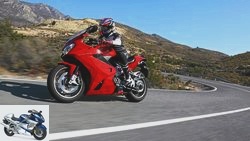
Tourer
Honda VFR 800 F in the driving report
Equipped for the future
read more
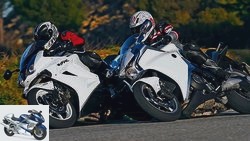
Tourer
Comparison test of the generations: Honda VFR
Honda VFR 800 versus VFR 1200 F
read more
Compared to the previous model, the bench is divided into two parts
Enough of the gray theory. The new Honda VFR 800 F in red is ready for test drive under a bright blue sky. Why the German importer decided to only offer the model in red and black in this country is a good question. After all, the VFR, which is also available in white in other European countries, looks really classy. The first sitting contact is friendly. Compared to the previous model, the bench is now divided into two parts. The driver’s seat can now be screwed in two positions: low (790 mm seat height) and high (810 mm). It’s cumbersome, but you usually only do it once. Or have you heard of people who are constantly growing or shrinking? Also new: the storage compartment.
Anyone who does not mount the supplied pillion bench with handle can use the space under the cover as storage space. A curse and a blessing at the same time: The days when the solo driver simply pushed the cover over the pillion seat are over for good. Nowadays you have to screw for a supersport look. When starting from cold, the V4 revs up quite high at 2500 rpm, but from the first meter it immediately hangs on the accelerator, and when you click into first gear it doesn’t clatter despite the high engine speeds. The hydraulically operated clutch of the Honda VFR 800 F is perfectly controllable and beyond any doubt.
New control electronics and ride-by-wire on board
If you own the predecessor model RC46, you will notice two things in the first few meters: The new Honda VFR 800 F (RC79) has noticeably lower load change reactions and also depends better on the gas. Both have to do with the new control electronics and the ride-by-wire that is now being used. Incidentally, this fully electronic type of accelerator is partly responsible for the smoother transition of the VTEC system, because the hardware of the system has remained the same. For all owners of an RC46 at this point a note: No, the new software or ride-by-wire cannot be retrofitted. According to Honda, this is not possible due to homologation regulations. In addition, the financial and technical effort would not be in a reasonable relationship to the benefit.
Use. Good cue. The top test is not the right place to generally question the VTEC system of the Honda VFR 800 F. But you could. Because instead of valve technology, which has to be laboriously maintained, a displacement increase to 1000 cubic was on the wish lists of many fans. Honda then decided to add a 1200 sister to the 800, but without the VTEC. For those who have never heard of this system: The VTEC (Variable Valve Timing and Lift Electronic Control) is intended to combine the advantages of two-valve technology with those of four-valve technology.
VTEC must be checked every 25,000 kilometers
Up to around 7000 rpm, only two valves per cylinder work on the Honda VFR 800 F. This is intended to increase the flow rate and thereby positively influence the degree of filling of the cylinders. Above 7000 rpm, two additional valves per cylinder are activated via an oil pressure-dependent connection. The large cross-section for ventilation of the cylinder, which is important for high speeds, is thus achieved. Since this is done via a separate cam, different cam profiles can be used: a profile optimized for consumption and smoothness for low speeds and a performance-optimized profile for high speeds. Nice and good. But what’s the point??
A general advantage over a conventional V4 engine with identical cubic capacity, such as that powered the VFR from the years 1998 to 2001, is not immediately apparent, at least in terms of performance. The VTEC is unquestionably proven and robust. But it is maintenance-intensive: it has to be specially checked every 25,000 kilometers. 5.5 workshop hours are specified for this. But let’s leave that. The die is cast. And in the case of the new Honda VFR 800 F, they are better than the previous model. The RC79 engine depends more directly on the gas, reacts more sensitively to commands and, at 4.7 liters per 100 kilometers, also consumes around half a liter less than the previous model. You can’t complain about that because the tank volume has been reduced from 22 to 21.5 liters. The range is still gigantic at 457 kilometers.
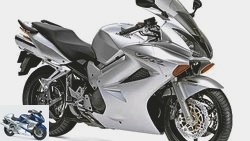
Used purchase
Second hand advice Honda VFR 750/800
The Honda sports tourer as a used one
read more
Superb workmanship, rich sound and a safe driving experience
Aside from any technology, this special, typical VFR feeling sets in on the new Honda VFR 800 F after just a few meters. If a motorcycle has ever managed to convey value, consistency and basic trust, it is the VFR. It starts with the superb workmanship that you admire while standing, continues with the grumbling, powerful sound and ends with the rich, safe driving experience. The suspension elements provide perfect feedback in all driving situations and are, as it were, linked to the nerves in the body. Nothing disturbs the machine. Harmony is the magic word.
She is fed up in the bends and steers precisely. The Honda VFR 800 F is like an ICE, which is given the rails via the legs and handlebars. Due to the changed weight distribution, the new one should be a bit more manageable. Let’s make it short: Instead of the powerful, high-installed double exhaust, the exhaust gases now hiss out of a single silencer that is conventionally screwed on at the bottom right. And the rear frame is now made of aluminum instead of steel. However, all these measures that have a positive effect on handling are not experienced on the road, but rather in the fast slalom of the top test. However, the special VFR feeling is not only linked to the chassis.
Precise, true to line, suitable for everyday use, robust, high quality: the strengths of the VFR have been further developed – a companion for life.
The engine of the Honda VFR 800 F also fits perfectly: When bumbling through the traffic jam, no nervous inline four-cylinder triggers and screams for speed and warns of any loss of time. No, the unique V4 almost conveys the calm of an air-cooled Harley V2 and transfers this casualness to the driver. On the other hand, the V4 can also be fast and burns down its purgatory above 7000 rpm. At this point at the latest, you can hear the riders of powerful naked bikes laughing or clearing their throat violently.
Right guys! 106 HP at 10,250 / min and 75 Nm at 8500 / min cause at most laughter when you let your pants down. But let’s stay down to earth. The performance of the Honda VFR 800 F is completely sufficient, not only in terms of the 782 cubic meters. With values like zero to 100 km / h in 3.6 seconds and a top speed of 242 km / h, you are well positioned for all eventualities. Who needs more??
The increase in strength of the previous model is more noticeable
The annoyance of the VTEC system of the first RC46 is thankfully alien to the new one. While the system was annoying with indecision when switching from two to four-valve operation around ten years ago, often switching back and forth at 7000 rpm and then suddenly serving more power, it works inconspicuously in the Honda VFR 800 F. Apart from a high-frequency snarling noise, which is suddenly accompanied by more tension on the chain, nothing can be felt. In other words: the increase in strength was more noticeable in the previous model, which can also be clearly seen on the performance diagram. The question remains whether it all had to be. Mainly because the new one has three hp and five Nm less thump than its predecessor.
Honda explains this step backwards with the adjustment to stricter emissions and noise regulations in view of the imminent introduction of Euro4 and Euro5. The technicians on the Honda VFR 800 F have put a lot of effort into this: electronics, ride-by-wire, valve timing, airbox, exhaust have been changed, the cooling system is even brand new. The radiator is now positioned across the direction of travel. As a result, a narrower cladding could be realized, which unfortunately also offers a little less protection from the wind and rain. Also new are the radially bolted four-piston fixed calipers at the front, which really don’t have a problem in any situation with the 245 kilogram load. The braking system is perfectly tailored to your application. So the stoppers can be dosed super, and the braking deceleration is very good at 9.5 m / s². The standard built-in ABS has been re-tuned and controls sensitively.
System designed for security
Honda has completely turned its back on the CBS integral brake system. In return, the Honda VFR 800 F has been given traction control for the first time. The system calculates the slip on the rear wheel using a wheel speed comparison. If that spins, the ignition and injection are immediately cut back, which is not done very sensitively, because the forward thrust of the engine is strongly inhibited for two or three seconds. The system is designed for safety and can also be deactivated using a button on the handlebar. The automatic turn signal reset is absolutely great. The system works regardless of the speed or the size of the radius and is currently the best on the market.
The key question remains: Since the used market is huge and all VFRs are ultimately unbreakable, what are the arguments in favor of buying the new Honda VFR 800 F? First owner pride, guarantee and of course the certainty that you will not have to invest any money in wearing parts for the next 25,000 kilometers – you are on the safe side. All VFR inexperienced people can only recommend a test drive that is longer than just around the block. Because often it is not love at first sight. This Vau for life, for example, creeps quietly but steadily into the heart. You just have to give her some time to do it.
Technical specifications
Hard at the limit: The Honda VFR 800 F has to show what it can do on the top test course.
Honda VFR 800 F.
MOTORCYCLE measurements
Henniges
Transmission measurements of the Honda VFR 800 F.
Mileage
Maximum speed (manufacturer information): 242 km / h
acceleration
0-100 km / h: 3.6 sec
0–140 km / h: 6.0 sec
0-200 km / h: 14.2 sec
Draft
60-100 km / h: 5.2 seconds
100–140 km / h: 6.2 sec
140–180 km / h: 8.6 sec
Speedometer deviation
Effective (display 50/100): 49/98 km / h
Tachometer deviation
Display red area: 12,500 rpm
Effective: 12,000 / min
consumption
Country road: 4.7 l / 100 km
At 130 km / h: 5.1 l / 100 km
Theor. Range of the highway: 457 km
Fuel type: Super
Dimensions + weights
L / W / H: 2170/890/1200 mm
Seat height: 780–800 mm
Handlebar height: 945 mm
Turning circle: 6300 mm
Weight with a full tank: 245 kg
Payload: 187 kg
Wheel load distribution v / h: 49.7 / 50.3%
Henniges
Engine measurements of the Honda VFR 800 F.
The transition to four-valve operation is much more harmonious with the Honda VFR 800 F than with the predecessor RC46. The curves clearly show what you can feel when driving: With the old VFR, the sudden power boost from the four valves is more noticeable.
But to neglect: Because in everyday situations, the extra power between 3000 and 5500 rpm is the significantly better bonus. The gear ratio is identical to that of the RC46.
Driving dynamics
Handling course I (fast slalom)
Lap time: 20.8 sec
Reference Kawasaki Z 1000 SX: 19.9 sec
Vmax at the measuring point: 103.8 km / h
Reference Kawasaki Z 1000 SX: 108.1 km / h
The Honda VFR 800 F would like to be driven through the fast slalom. It remains stable and precise to steer. However, the high weight is noticeable.
Handling course II (slow slalom)
Lap time: 29.2 sec
Reference Kawasaki Z 1000 SX: 29.0 sec
vmax at the measuring point: 53.1 km / h
Reference Kawasaki Z 1000 SX: 53.4 km / h
In the slow slalom, the Honda VFR 800 F circles precisely around the pylons. The lean angle is sufficient and therefore leaves
good times and speed too.
Circular path (Ø 46 meters)
Lap time: 10.9 sec
Reference Kawasaki Z 1000 SX: 10.8 sec
vmax at the measuring point: 49.2 km / h
Reference Kawasaki Z 1000 SX: 52.5 km / h
The Honda VFR 800 F lies well in the circular path, the speed only has to be reduced at the parting line, otherwise the front wheel will lose its grip.
Henniges
Brake measurements of the Honda VFR 800 F.
Although the fork plunges very deeply when braking hard, the Honda VFR 800 F still remains stable on course and the rear wheel always maintains contact with the ground. The deceleration performance of 9.5 m / s² is quite high by Honda standards.
Other models from the manufacturer only slightly exceed the value of 9.0 m / s². ABS and chassis setup harmonize perfectly. Fading is a foreign word.
Comparison of the RC46 VTEC with the RC79
Henniges
The Honda VFR 800 F looks more delicate and is slightly lighter than its predecessor. Is this really noticeable when driving?
No stone was left unturned under the plastic dress. The radiators, which were formerly placed on the side, are now back in the center of the front, the rear frame has been redesigned and the two formerly high, bulky-looking rear silencers have given way to a single pot mounted on the side. The Honda VFR 800 F is seven kilos lighter than its predecessor. In addition, Honda has smoothed the transition from two- to four-valve operation of the VTEC. To cut a long story short: they did not reinvent the wheel. Nevertheless, these measures are noticeable. The hardware of the VTEC is largely identical.
Fundamental changes can be found in the control electronics, and a ride-by-wire system is now used. In a direct comparison, the extra power when switching to four-valve operation is not as unpleasantly noticeable as with the RC46. The power output is more harmonious than with the old system. The load change reactions are less and the V4 depends much more directly on the gas. The test copy was also superior to its predecessor in terms of smoothness. The small changes such as the revised chassis setup, the stiffer swing arm or the slightly changed seating position also have an effect: The Honda VFR 800 F drives a nuance more precisely, steers a touch more neutrally and gives the driver a better and safer bottom line Feeling for the motorcycle and everything he does with it. The new, radially bolted brake calipers decelerate at least as much, even without CBS. The Japanese only went backwards with the lighting, because the illumination of the RC46 headlights was significantly better.
competitor
Bilski
Along with the BMW F 800 GT, the Kawasaki Z 1000 SX is the main competitor of the Honda VFR 800 F..
BMW F 800 GT
Two-cylinder in-line engine, 89.8 hp, weight 221 kg, 0-100 km / h 3.9 sec, Vmax 224 km / h, consumption 3.9 liters, price including ancillary costs 10,790 euros.
Kawasaki Z 1000 SX
Four-cylinder in-line engine, 142.1 hp, weight 235 kg, 0-100 km / h 3.3 seconds, Vmax 249 km / h, consumption 5.6 liters, price including ancillary costs 12,975 euros.
MOTORCYCLE scoring
A beautiful back can also delight: The rear of the Honda VFR 800 F is a success, the indicators are well integrated.
engine
| maximum number of points | Honda VFR 800 F. | |
| Draft | 40 | 18th |
| acceleration | 40 | 26th |
| Top speed | 30th | 21st |
| Engine characteristics | 30th | 16 |
| Responsiveness | 20th | 14th |
| Load change | 20th | 13 |
| Smoothness | 20th | 13 |
| coupling | 10 | 8th |
| circuit | 20th | 14th |
| Gear ratio | 10 | 7th |
| Start | 10 | 6th |
| total | 250 | 156 |
You shouldn’t expect miracles in terms of pulling power or acceleration in view of 106 hp and 245 kg. On the other hand, the engine of the Honda VFR 800 F runs smoothly, hardly vibrates and hangs well on the gas. The V4 reproduces its performance in a linear manner, is powerful in the middle, and doesn’t run out of breath at the top either. The hydraulically actuated clutch can be perfectly adjusted, but the operating forces could be a bit lower. Annoying: After a cold start, the V4 revs up to around 2500 rpm. The circuit is precise and smooth.
landing gear
| maximum number of points | Honda VFR 800 F. | |
| Handiness | 40 | 26th |
| Stability in turns | 40 | 29 |
| Steering behavior | 40 | 29 |
| feedback | 10 | 8th |
| Inclined position | 20th | 17th |
| Straight-line stability | 20th | 18th |
| Suspension tuning in front | 20th | 15th |
| Chassis set-up at the rear | 20th | 15th |
| Adjustment options undercarriage | 10 | 6th |
| Suspension comfort | 10 | 7th |
| Driving behavior with a passenger | 20th | 13 |
| total | 250 | 183 |
The ICE symptom is still there: the Honda VFR 800 F is extremely stable, drives almost as if on rails and steers itself very precisely. Steering corrections are possible in any situation, but the 800 is not particularly handy. The weight is also noticeable. The new chassis set-up is an all-round success, it gives the driver good feedback on the road and strikes the ideal compromise between sporty, firm and comfort. This also applies to trips for two. In contrast to its predecessor, the fork now also has rebound adjustment.
everyday life
| maximum number of points | Honda VFR 800 F. | |
| Ergonomics driver | 40 | 27 |
| ErgonomicsSocius | 20th | 13 |
| Windbreak | 20th | 12th |
| view | 20th | 12th |
| light | 20th | 11 |
| Furnishing | 30th | 27 |
| Handling / maintenance | 30th | 16 |
| Luggage storage | 10 | 2 |
| Payload | 10 | 5 |
| Range | 30th | 30th |
| processing | 20th | 15th |
| total | 250 | 170 |
Those who are slim do not always have advantages. The new cladding, for example, is slimmer than that of its predecessor and therefore offers slightly poorer wind protection. The new LED headlights are also dazzlingly bright. You are guaranteed not to be overlooked. However, it only illuminates over a large area, the light of the predecessor was much better, as it illuminated the road better. You also saw more in the mirrors of the predecessor. The Honda VFR 800 F scores with the equipment: heated grips, traction control, automatic turn signal reset – all as standard.
security
| maximum number of points | Honda VFR 800 F. | |
| Braking effect | 40 | 31 |
| Brake metering | 30th | 24 |
| Braking with a passenger / fading | 20th | 14th |
| Righting moment when braking | 10 | 7th |
| ABS function | 20th | 14th |
| Handlebar slapping | 20th | 17th |
| Ground clearance | 10 | 8th |
| total | 150 | 115 |
Goodbye composite braking system – the Honda VFR 800 F still brakes better. The control behavior of the ABS is even finer and more effective than that of the predecessor. In addition, the new brake system has a crystal-clear pressure point and works almost fading-free. The new fork setup reduces the impulses for handlebar flapping.
costs
| Maximum number of points | Honda VFR 800 F. | |
| guarantee | 30th | 15th |
| Consumption (country road) | 30th | 21st |
| Inspection costs | 20th | 18th |
| Maintenance costs | 20th | 9 |
| total | 100 | 63 |
Extended: The Honda VFR 800 F not only consumes less, in contrast to its predecessor (every 6000 km) it also only has to be serviced every 12,000 km. The expensive maintenance work on the VTEC system remains, however.
Overall rating
| maximum number of points | Honda VFR 800 F. | |
| Overall rating | 1000 | 687 |
| Price-performance note | 1.0 | 1.6 |
Respect! The points confirm it: The Honda VFR 800 F is a good motorcycle, the price of which is fully justified with a price-performance rating of 1.6.
Conclusion Honda VFR 800 F
The Honda VFR 800 F drives even smoother and more precisely than its predecessor.
Compared to its predecessor, the Honda VFR 800 F has become more harmonious. It drives softer and more precisely, is more stable and is a bit more manageable. Features such as traction control, a superb ABS or the new automatic turn signal reset make the VFR safer and more suitable for everyday use. The processing is still at the top level. What was true 25 years ago is still true today: The VFR is a Vau for life.
Related articles
-
Top test: Kawasaki ZX-10R old-new
Top test: Kawasaki ZX-10R old / new The double top test of the old and new 10 ninja The ZX-10R has never lacked power. But now the tens…
-
fact Concept comparison Honda CBR 1100 XX Kawasaki ZX-12 R Suzuki GSX-R 1000 Suzuki GSX 1400 Yamaha FZS 1000 Fazer Yamaha FJR 1300 Six bombs The six …
-
Kawasaki Ninja H2 in the top test
Bilski 26 pictures Bilski 1/26 Mi 218 hp, the H2 is the most powerful bike on the MOTORRAD test bench to date. Bilski 2/26 The polished stainless steel elbows form …
-
BMW F 800 GT, Kawasaki Z 1000 SX and Honda VFR 800 F in the test
fact 44 pictures fact 1/44 fact 2/44 fact 3/44 fact 4/44 fact 5/44 Praise to the diversity: The three test candidates all want the same thing, but are looking for it …
-
factstudio.de 15th photos factstudio.de 1/15 Honda CB 1000 R + in the top test. factstudio.de 2/15 The design line of the new CB 1000 R is called “Neo…
-
fact Top test Honda Varadero 1000 Pleasure ship Truly a monumental motorcycle, weighing 267 kilograms, as high as a cathedral, comfortable and fast. In…
-
Aprilia RSV4 RF and Yamaha YZF-R1M in comparison test
40 photos markus-jahn.com 1/40 Aprilia RSV4 RF and Yamaha YZF-R1M in comparison test. markus-jahn.com 2/40 You sit quite high on both bikes, but with the…
-
Artist 13 photos Artist 1/13 The on-board tool kit of the BMW almost ties in with old traditions. With the help of the nine-piece set, you can strip the…
-
Honda CB 1100 R, Honda VF 1000 R in the test
Jahn 16 photos Jahn 1/16 Athletes in tails – a comparison of the two long-distance racers from the Honda brand. Jahn 2/16 A very fine detail borrowed…
-
Endurance test Honda VFR CBS-ABS
Bilski long-term test Honda VFR CBS-ABS The all-round carefree package The rough edges of the VFR are limited to the outside. Sit on it and feel good means …